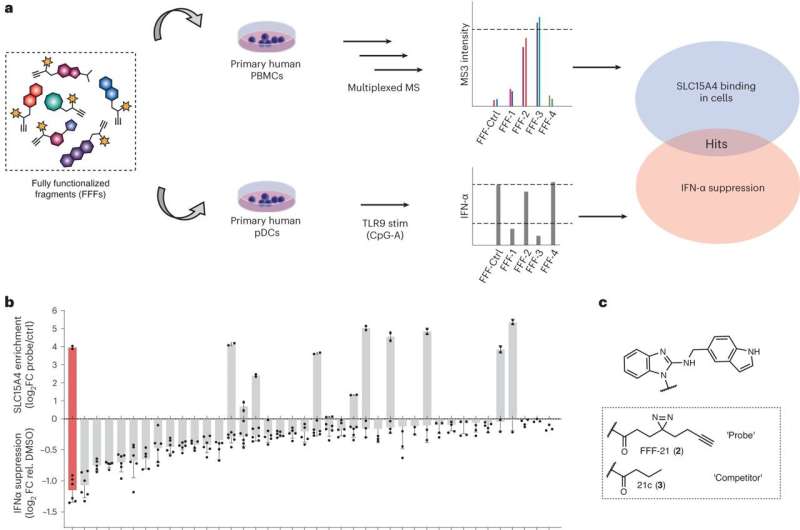This article has been reviewed according to Science X's editorial process and policies. Editors have highlighted the following attributes while ensuring the content's credibility:
fact-checked
peer-reviewed publication
trusted source
proofread
New immune system-targeting compound shows early promise in treating lupus

Scientists from Scripps Research have developed a small molecule that blocks the activity of a protein linked to autoimmune diseases, including systemic lupus erythematosus (SLE) and Crohn's disease. This protein, known as SLC15A4, has been considered largely "undruggable," as most researchers have long struggled to isolate the protein, determine its structure, or even pin down its exact function within immune cells—until now.
The research, published in Nature Chemical Biology, shows that the compound successfully reduced inflammation in mouse models of inflammation, as well as in isolated cells from people diagnosed with lupus. This provides scientists with a new tool to study the role of SLC15A4 in autoimmunity, as well as a potential new therapy to move toward additional preclinical trials.
"This is an example of a protein that had been correlated with disease in a number of ways, including human genetics and various disease models, but no one had been able to develop small molecules to target it," says senior author Christopher Parker, Ph.D., associate professor in the Department of Chemistry at Scripps Research. "We not only created such a compound, but we validated that it can have therapeutic effects."
SLC15A4 was first characterized in 2010 by Bruce Beutler, MD, who at the time was the Chair of Genetics at Scripps Research (he is now at University of Texas Southwestern Medical Center). His work established that SLC15A4 proteins play a key role in controlling immune responses and that higher levels of the proteins are associated with inflammation. Beutler, along with Ari Theofilopoulos, MD, now professor emeritus in the Department of Immunology and Microbiology, also showed that removing the SLC15A4 gene from mice with lupus ameliorated their disease.
Other studies have since found that SLC15A4 is present at higher levels in some patients with lupus and Crohn's disease, and that certain people with SLC15A4 mutations make them less likely to develop these diseases. However, researchers have struggled to study the protein.
"It is an incredibly complicated protein that is embedded in very specific membranes within immune cells," says John Teijaro, Ph.D., professor in the Department of Immunology and Microbiology and co-senior author of the new work. "It doesn't behave very well when you remove it from this environment, which makes it incredibly difficult to carry out most typical assays or drug screens."
Parker's lab, however, has pioneered methods to introduce chemical probes to living cells and screen which probes bind to a protein of interest—like SLC15A4—without ever removing the protein from its environment in the cell. In the new study, they used this approach to discover nine different molecular fragments that could all bind to SLC15A4 proteins inside human immune cells. They carried out a variety of experiments to prove that one of these fragments, FFF-21, was both physically attaching to SLC15A4 and impeding its function in promoting inflammation.
"This not only helps move forward research on SLC15A4, but also validates our overall approach," says Parker. "This general strategy can be applied to lots of other challenging drug targets."
The researchers went on to create dozens of modified versions of FFF-21, studying whether any had more potent effects. One variation, dubbed AJ2-30, worked particularly well. In multiple cell types, including healthy human immune cells and cells from people with lupus, AJ2-30 blocked the function of SLC15A4 and stopped inflammation. When cells lacked the gene for SLC15A4, the drug no longer worked, verifying that its interactions with SLC15A4 were key. Additional experiments revealed that AJ2-30 not only blocked SLC15A4, but also caused it to be degraded by cells.
"We didn't know until now whether pharmaceutically blocking SLC15A4 could lessen some of the cellular signs of lupus, but in this paper, we showed that it does that," says Teijaro. "We don't yet have data on other diseases, but we suspect that there are a number of other autoimmune diseases that a molecule like this could be effective for."
Further studies are needed before AJ2-30 or related compounds can be tested clinically, but the researchers say the ability to block SLC15A4 opens new doors for both studying and eventually treating autoimmune diseases. The team is planning to design new improved versions of the drug to continue studying.
In addition to Parker and Teijaro, authors of the study include co-first authors Tzu-Yuan Chiu Daniel C. Lazar, and Wesley W. Wang, as well as Jacob M. Wozniak, Appaso M. Jadhav, Weichao Li, Nathalia Gazaniga and Argyrios N. Theofilopoulos of Scripps Research.
More information: Tzu-Yuan Chiu et al, Chemoproteomic development of SLC15A4 inhibitors with anti-inflammatory activity, Nature Chemical Biology (2024). DOI: 10.1038/s41589-023-01527-8

















